Oct. 28 to Nov. 3
In late 1927, Taiwan’s cultural elite were shocked to find that none of their prominent artists were selected to participate in the inaugural Taiwan Arts Exhibition. Instead, three unknown 19-year-olds were the only Taiwanese to make the cut for the government-sponsored show: Kuo Hsueh-hu (郭雪湖), Lin Yu-shan (林玉山) and Chen Chin (陳進).
The trio were dubbed the “Three Youths” (三少年), and the uproar over the incident launched their prestigious and fruitful careers. Chen is especially known as Taiwan’s first female painter, and her distinct depictions of female figures is instantly recognizable.
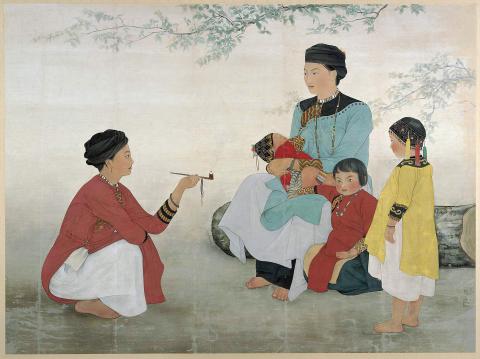
Photo: Ling Mei-hsueh, Taipei Times
According to the introduction to the 2009 exhibit, “The Three Youths of Taiwan Fine Arts Exhibition” (台展三少年), they were selected “due to their pure, fresh and realistic style of painting from [everyday] life” that broke away from traditional practices.
“These three youths used gouache, color ink and other media to express their deep personal feelings and in-depth observations regarding the scenery, personages and conditions of the people of their homeland.”
All three lived extremely long lives, with Kuo the last to pass away — in 2012 — at the age of 104. Chen painted well into the 1990s, with her subject matter continuously reflecting changes in society and her life — for example, in 1994, she completed Playing Video Games (玩電玩), which depicted her two grandsons playing Super Mario Brothers in their living room.
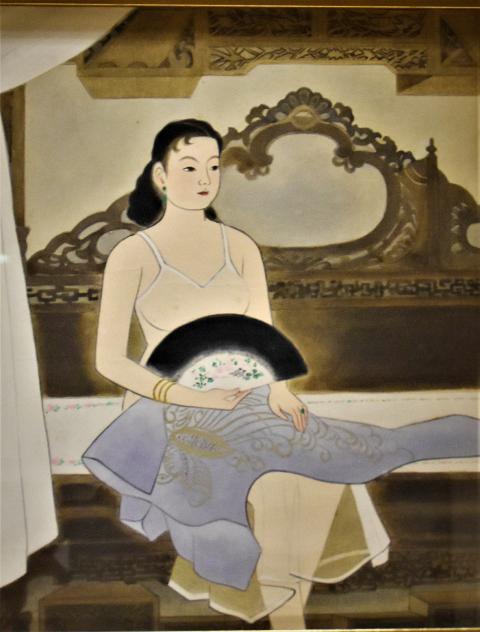
Photo courtesy of Wikimedia Commons
RISE TO FAME
Chen was born into a wealthy family in Hsinchu on Nov. 2, 1907. At the age of 15, she entered Taipei’s Third Girls High School (today’s Zhongshan Girls High School) and picked up the paintbrush for the first time. While she excelled in many subjects, it was her art teacher Gobara Koto who strongly encouraged her to pursue art. Chen’s father agreed right away.
In the spring of 1925, Chen boarded a ship bound for Japan to study at the prestigious Women’s School of Fine Arts. The Tokyo University of the Arts did not accept females until 1946.
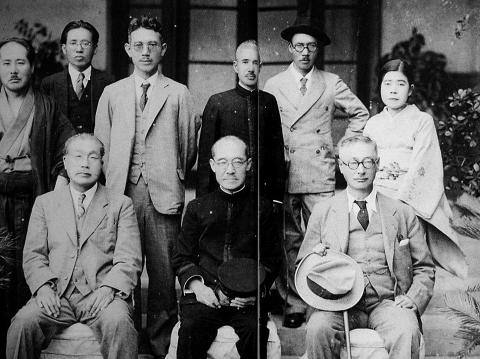
Photo courtesy of Wikimedia Commons
In those days, studying abroad was reserved for privileged families, and usually reserved for sons. It was even uncommon to study the arts — renowned painter Yang San-lang (楊三郎) had to secretly board a ship to Japan to pursue his studies. But Chen’s father fully supported her endeavors while most of her classmates got married and had children. In fact, she became the first Taiwanese woman to study art in Japan.
“I’m very fortunate to have an open-minded father, who was willing to spend any amount of money for my education,” she says. But he was also very strict, often scolding Chen for not working hard enough.
Two years later, Chen became a household name due to the media frenzy surrounding her selection to the Taiwan Fine Arts Exhibition. The established artists who were not chosen criticized the decision, and held their own “exhibit for the rejected” in the Taiwan Daily News (台灣日日新報) headquarters.
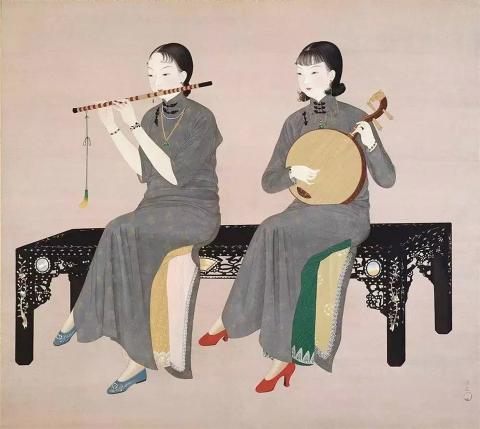
Photo: Sun Yi-fang, Taipei Times
The Fine Arts Exhibition was a government directive to steer Taiwan’s art scene away from traditional Chinese influences and toward modern and Western styles in tune with the Meiji Restoration.
“This island, which had little culture, has been under Japanese rule for 30 years and its artistic taste has greatly improved,” read an official statement.
This is the main reason why the established painters were not chosen, as the colonial government preferred young Taiwanese who were born and raised under Japanese rule. Chen continued to shine in the exhibition in the following years.
Although her artistic education was completely Japanese, her work still mostly focused on daily life of mostly upper class Taiwanese women.
Eight years later, Chen made the news again when her iconic painting Ensemble (合奏) made it into the Imperial Fine Arts Academy Exhibition in Tokyo. The two female musicians in the piece sat on distinctly Taiwanese chairs, played traditional instruments and dressed in the typical fashion of Taiwanese upper class ladies in the 1930s.
The newspapers jumped on the achievement by a young woman from a backwater colony, further bolstering her reputation. “Taiwan is a wonderful place,” she told the Japanese reporters. “Who doesn’t love the place they grew up in?”
REFLECTING THE DECADES
In 1934, Chen returned home to teach art at Pingtung Girls High School, becoming Taiwan’s first female high school teacher. She often visited the Paiwan Aborigines in the Sandimen area, resulting in her well-known Women of Sandimen (三地門之女).
When World War II broke out, Chen’s paintings also reflected the tension of the times, with one piece depicting two women reading a news article about the Japanese occupation of Hong Kong. Even so, her subjects’ expressions remained calm and graceful. After the Japanese defeat, the “Three Youths” served among the judges at the first Taiwan Provincial Fine Arts Exhibition in 1946.
Chen was so immersed in her art that she didn’t get married until the age of 40. Her son was born four years later, and her subject matter shifted toward family life.
However, as China fell to the communists in 1949, many renowned Chinese artists fled to Taiwan. Coupled with the Chinese Nationalist Party’s (KMT) promotion of Chinese culture and efforts to purge Taiwan of Japanese influence, Japanese-educated artists such as Chen quickly lost prestige. She regained her passion after a painting made it to a national exhibition in Japan, and funded her own art show at Taipei’s Zhongshan Hall in 1958.
She soon fell ill, and spent the next two years in recovery. During this time, she worked on a series of commissions by a Buddhist master, and converted to the religion when she was done. Buddhist imagery became a frequent subject in her paintings from then on.
Chen’s paintings continued to mark the significant events in her life — from her wedding night to her travels to the US, her son getting married and the birth of her first grandchild. Her Family Portrait (全家福) brings her life journey full circle, as she depicts herself as an old lady, enjoying her time with her loved ones.
Taiwan in Time, a column about Taiwan’s history that is published every Sunday, spotlights important or interesting events around the nation that ha ve anniversaries this week.

The People’s Republic of China (PRC) last week offered us a glimpse of the violence it plans against Taiwan, with two days of blockade drills conducted around the nation and live-fire exercises not far away in the East China Sea. The PRC said it had practiced hitting “simulated targets of key ports and energy facilities.” Taiwan confirmed on Thursday that PRC Coast Guard ships were directed by the its Eastern Theater Command, meaning that they are assumed to be military assets in a confrontation. Because of this, the number of assets available to the PRC navy is far, far bigger

The 1990s were a turbulent time for the Chinese Nationalist Party’s (KMT) patronage factions. For a look at how they formed, check out the March 2 “Deep Dives.” In the boom years of the 1980s and 1990s the factions amassed fortunes from corruption, access to the levers of local government and prime access to property. They also moved into industries like construction and the gravel business, devastating river ecosystems while the governments they controlled looked the other way. By this period, the factions had largely carved out geographical feifdoms in the local jurisdictions the national KMT restrained them to. For example,

The remains of this Japanese-era trail designed to protect the camphor industry make for a scenic day-hike, a fascinating overnight hike or a challenging multi-day adventure Maolin District (茂林) in Kaohsiung is well known for beautiful roadside scenery, waterfalls, the annual butterfly migration and indigenous culture. A lesser known but worthwhile destination here lies along the very top of the valley: the Liugui Security Path (六龜警備道). This relic of the Japanese era once isolated the Maolin valley from the outside world but now serves to draw tourists in. The path originally ran for about 50km, but not all of this trail is still easily walkable. The nicest section for a simple day hike is the heavily trafficked southern section above Maolin and Wanshan (萬山) villages. Remains of
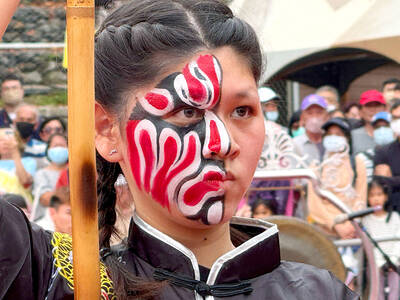
Shunxian Temple (順賢宮) is luxurious. Massive, exquisitely ornamented, in pristine condition and yet varnished by the passing of time. General manager Huang Wen-jeng (黃文正) points to a ceiling in a little anteroom: a splendid painting of a tiger stares at us from above. Wherever you walk, his eyes seem riveted on you. “When you pray or when you tribute money, he is still there, looking at you,” he says. But the tiger isn’t threatening — indeed, it’s there to protect locals. Not that they may need it because Neimen District (內門) in Kaohsiung has a martial tradition dating back centuries. On